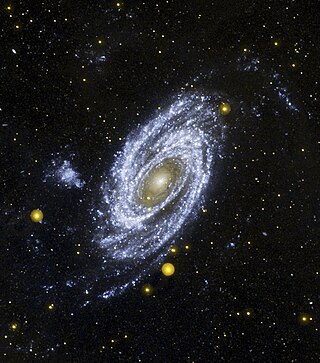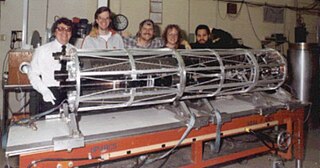
A corona is the outermost layer of a star's atmosphere. It consists of plasma.

X-ray astronomy is an observational branch of astronomy which deals with the study of X-ray observation and detection from astronomical objects. X-radiation is absorbed by the Earth's atmosphere, so instruments to detect X-rays must be taken to high altitude by balloons, sounding rockets, and satellites. X-ray astronomy uses a type of space telescope that can see x-ray radiation which standard optical telescopes, such as the Mauna Kea Observatories, cannot.

Ultraviolet astronomy is the observation of electromagnetic radiation at ultraviolet wavelengths between approximately 10 and 320 nanometres; shorter wavelengths—higher energy photons—are studied by X-ray astronomy and gamma-ray astronomy. Ultraviolet light is not visible to the human eye. Most of the light at these wavelengths is absorbed by the Earth's atmosphere, so observations at these wavelengths must be performed from the upper atmosphere or from space.
The Extreme ultraviolet Imaging Telescope (EIT) is an instrument on the SOHO spacecraft used to obtain high-resolution images of the solar corona in the ultraviolet range. The EIT instrument is sensitive to light of four different wavelengths: 17.1, 19.5, 28.4, and 30.4 nm, corresponding to light produced by highly ionized iron (XI)/(X), (XII), (XV), and helium (II), respectively. EIT is built as a single telescope with a quadrant structure to the entrance mirrors: each quadrant reflects a different colour of EUV light, and the wavelength to be observed is selected by a shutter that blocks light from all but the desired quadrant of the main telescope.

ROSAT was a German Aerospace Center-led satellite X-ray telescope, with instruments built by West Germany, the United Kingdom and the United States. It was launched on 1 June 1990, on a Delta II rocket from Cape Canaveral, on what was initially designed as an 18-month mission, with provision for up to five years of operation. ROSAT operated for over eight years, finally shutting down on 12 February 1999.

Transition Region and Coronal Explorer was a NASA heliophysics and solar observatory designed to investigate the connections between fine-scale magnetic fields and the associated plasma structures on the Sun by providing high resolution images and observation of the solar photosphere, the transition region, and the solar corona. A main focus of the TRACE instrument is the fine structure of coronal loops low in the solar atmosphere. TRACE is the third spacecraft in the Small Explorer program, launched on 2 April 1998, and obtained its last science image on 21 June 2010, at 23:56 UTC.

The Array of Low Energy X-ray Imaging Sensors X-ray telescope featured curved mirrors whose multilayer coatings reflected and focused low-energy X-rays or extreme ultraviolet (EUV) light the way optical telescopes focus visible light. The satellite and payloads were funded by the United States Department of Energy and built by Los Alamos National Laboratory (LANL) in collaboration with Sandia National Laboratories and the University of California-Space Sciences Lab. The satellite bus was built by AeroAstro, Inc. of Herndon, VA. The Launch was provided by the United States Air Force Space Test Program on a Pegasus Booster on April 25, 1993. The mission was entirely controlled from a small groundstation at LANL.

The Multi-spectral solar telescope array, or MSSTA, was a sounding rocket payload built by Professor A.B.C. Walker, Jr. at Stanford University in the 1990s to test EUV/XUV imaging of the Sun using normal incidence EUV-reflective multilayer optics. MSSTA contained a large number of individual telescopes, all trained on the Sun and all sensitive to slightly different wavelengths of ultraviolet light. Like all sounding rockets, MSSTA flew for approximately 14 minutes per mission, about 5 minutes of which were in space—just enough time to test a new technology or yield "first results" science. MSSTA is one of the last solar observing instruments to use photographic film rather than a digital camera system such as a CCD. MSSTA used film instead of a CCD in order to achieve the highest possible spatial resolution and to avoid the electronics difficulty presented by the large number of detectors that would have been required for its many telescopes.
Arthur Bertram Cuthbert Walker Jr. was an African-American solar physicist and a pioneer of EUV/XUV optics. He is most noted for having developed normal incidence multilayer XUV telescopes to photograph the solar corona. Two of his sounding rocket payloads, the Stanford/MSFC Rocket Spectroheliograph Experiment and the Multi-Spectral Solar Telescope Array, recorded the first full-disk, high-resolution images of the Sun in XUV with conventional geometries of normal incidence optics; this technology is now used in solar telescopes such as SOHO/EIT and TRACE, and in the fabrication of microchips via ultraviolet photolithography.

Hinode, formerly Solar-B, is a Japan Aerospace Exploration Agency Solar mission with United States and United Kingdom collaboration. It is the follow-up to the Yohkoh (Solar-A) mission and it was launched on the final flight of the M-V rocket from Uchinoura Space Center, Japan on 22 September 2006 at 21:36 UTC. Initial orbit was perigee height 280 km, apogee height 686 km, inclination 98.3 degrees. Then the satellite maneuvered to the quasi-circular sun-synchronous orbit over the day/night terminator, which allows near-continuous observation of the Sun. On 28 October 2006, the probe's instruments captured their first images.

In solar physics, a coronal loop is a well-defined arch-like structure in the Sun's atmosphere made up of relatively dense plasma confined and isolated from the surrounding medium by magnetic flux tubes. Coronal loops begin and end at two footpoints on the photosphere and project into the transition region and lower corona. They typically form and dissipate over periods of seconds to days and may span anywhere from 1 to 1,000 megametres in length.

Rocket astrophysical observatories K-2, K-3 and K-4 were launched in Soviet Union in the 1960s and early 1970s under the direction of Grigor Gurzadyan of Byurakan Observatory in Armenia, for the study of the Solar ultraviolet and X-ray emission.

OSO 7 or Orbiting Solar Observatory 7, before launch known as OSO H is the seventh in the series of American Orbiting Solar Observatory satellites launched by NASA between 1962 and 1975. OSO 7 was launched from Cape Kennedy on 29 September 1971 by a Delta N rocket into a 33.1° inclination, low-Earth orbit, and re-entered the Earth's atmosphere on 9 July 1974. It was built by the Ball Brothers Research Corporation (BBRC), now known as Ball Aerospace, in Boulder Colorado.

A nanoflare is a very small episodic heating event which happens in the corona, the external atmosphere of the Sun.

The High Resolution Coronal Imager (Hi-C) is a sub-orbital telescope designed to take high-resolution images of the Sun's corona. As of 2020 it has been launched three times, but only the first and the third launches, on July 11, 2012, and May 29, 2018, resulted in a successful mission. It was launched aboard a Black Brant sounding rocket from White Sands Missile Range, New Mexico. The images taken were the highest resolution photos ever of the Sun's corona.

Craig Edward DeForest is an American solar physicist and the Chair of the American Astronomical Society's Solar Physics Division. He leads the heliophysics research group at the Boulder, Colorado offices of the Southwest Research Institute and holds an adjunct faculty position at the University of Colorado, Boulder. His wide-ranging contributions to the field of experimental astrophysics of the Sun include: early work on the MSSTA, a sounding rocket that prototyped modern normal-incidence EUV optics such as are used on the Solar Dynamics Observatory; his discovery of sound waves in the solar corona in 1998; standardization of computer vision techniques that are used to measure and track magnetic fields on the solar surface; co-invention with colleague Charles Kankelborg of the fluxon semi-Lagrangian approach to numerical MHD modeling; and pioneering work on quantitative remote sensing of the solar wind via Thomson scattered light.

The Focusing Optics X-ray Solar Imager, or FOXSI, is a sounding rocket payload built by UC Berkeley and led by Säm Krucker to test high energy grazing-incidence focusing optics paired with solid-state pixelated detectors to observe the Sun. FOXSI is composed of seven identical Wolter-I telescope modules, as well as Silicon and Cadmium Telluride strip detectors originally developed for the HXT telescope on the Japanese Hitomi mission. The FOXSI payload flew two times, most recently in 2014 and previously in 2012. Like most sounding rockets, FOXSI flew for approximately 15 minutes per mission and observed the Sun for about 5 minutes while in space. During its first flight, FOXSI successfully imaged a solar microflare in the hard x-ray band for the first time.
Katharine Reeves is an astronomer and solar physicist who works at the Center for Astrophysics | Harvard & Smithsonian (CfA).. She is known for her work on high temperature plasmas in the solar corona, and measurement/analysis techniques to probe the physics of magnetic reconnection and thermal energy transport during solar flares; these are aspects of the coronal heating problem that organizes a large part of the field. She has a strong scientific role in multiple NASA and international space missions to observe the Sun: Hinode ; IRIS ; SDO; Parker Solar Probe; and suborbital sounding rockets including the MaGIXS and Hi-C FLARE high-resolution spectral imaging packages.

Hakeem Muata Oluseyi is an American astrophysicist, cosmologist, inventor, educator, science communicator, author, actor, veteran, and humanitarian.















